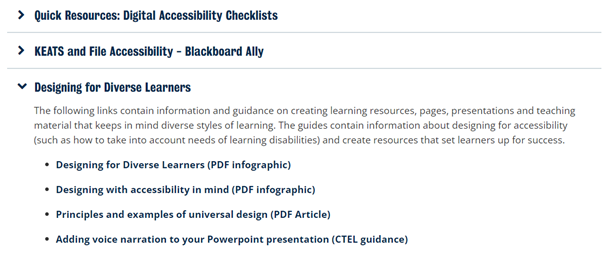This article has been divided in two parts. Part 1 discusses how the SSPP TEL team works to boost staff understanding of digital accessibility baseline. Part 2 provides an overview of the TEL training sessions available on the subject.
Allyship:
“the state of being an ally (= a person who helps and supports somebody) to a particular group of people that you yourself do not belong to, in order to help ensure their basic rights and ability to be happy and successful in society”- Oxford learner’s dictionary
What does digital accessibility mean to me? It means being able to embrace a platform for its intended use, because the people building it know how to create a great user experience – anticipating, rather than reacting to the needs of our diverse learning community. Being an ally.
At the moment, there is still room for improvement at King’s College London. The urgent relevance of focusing on digital accessibility as a King’s community cannot be stated better than it does in the recent Student Digital Accessibility Report from Miranda Melcher.
This report highlighted voices of 540 KCL students on both user experiences of KEATS, module organisation and assessment, as well as teaching and information practices. See a qualitative piece of feedback from SSPP and Arts & Hums students on using KEATS:
“It’s been really hard using KEATS. Each module lead is using it differently (e.g. interpreting headers differently), the design of it is not accessible and difficult to easily navigate, you have to jump across many different pages to get information needed, pages often don’t match up to the my timetable or teams invites, we don’t get notifications of questions on the forums and some lecturers are not responding quickly or at all on these, etc. Overall the design is just really not user friendly.” (shared by BA SSPP & BA Arts & Hums & SSPP MA students)
My takeaways from the wider report focused on the challenge that a lot of user experience issues are broad, making it difficult to make quick changes: we are talking about module level issues repeated across faculties. It’s a grassroot issue that spreads across fields. However, a connecting thread can be suggested as knowledge gaps on basics of digital accessibility.
How Faculty of Social Science & Public Policy (SSPP) TEL integrate Digital Accessibility to our information resources, training and wider strategy
In the next part of this blog I will discuss how the SSPP TEL team work to plug knowledge gaps and encourage early onboarding of SSPP colleagues to boost staff understanding of digital accessibility baseline.
Part 1: TEL Hubs
Over the past 6 months, the SSPP TEL team have rebuilt our Faculty Hub and TEL Hub. These pages act as faculty-level repositories of information aimed at staff and students. Including digital accessibility to these repositories was a core goal of the project. Below are some practical examples of how I embedded these to the faculty pages.

A dedicated section for digital accessibility was built in the TEL Hub. The section gave an introduction and housed four levels of information for staff:
- Quick Resources: checklists from across CTEL and KCL faculties for daily tasks on KEATS, MS Office and CMS. The aim of this section was to highlight guides that had a short read time that ensured “quick wins”.
- KEATS and file accessibility section was added to ensure staff knew about basic functions of Blackboard Ally and where to find central guidance and training
- Designing for diverse learners: this expanded on the quick resources with a focus on web accessibility and universal user design in both infographic and text format. Resources were brought in from internal (CTEL) and external (for example gov.uk) sources.
- Policies and regulations: this section included reminders such as KCL accessibility report, along with KCL D&I commitments that aimed at putting the above resources to the institutional context.
For a closer look, you can explore the digital accessibility section yourself by navigating to the SSPP TEL Hub (only available to KCL staff members).
Written by Laura Patari
Laura Patari is a Technology-Enhanced Learning Officer at the Faculty of Social Sciences and Public Policy and has worked in e-learning and digital information management for over 3 years.
She has a keen interest in human-centered design, digital accessibility and supporting lifelong learning.
1 thought on “Part 1: Embedding Digital Accessibility to the heart of everyday TEL work”